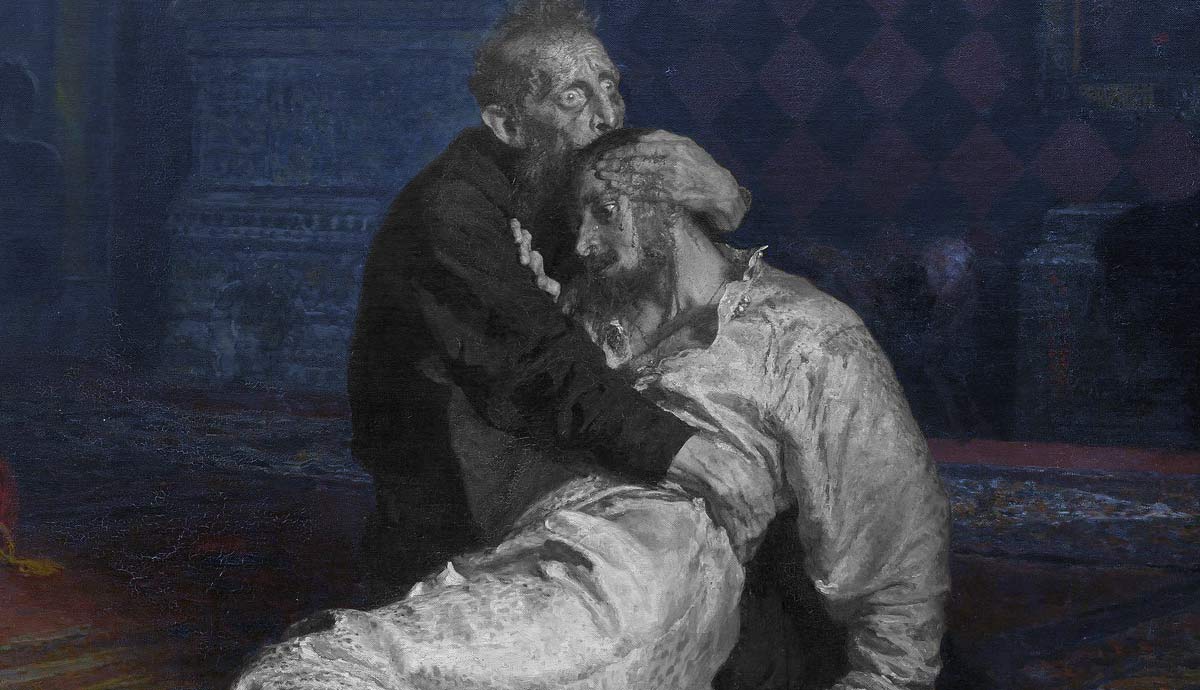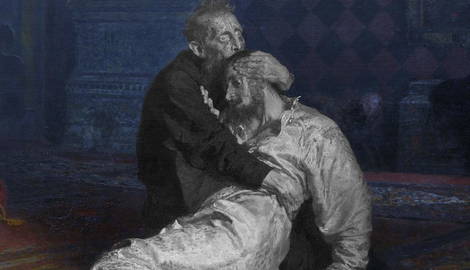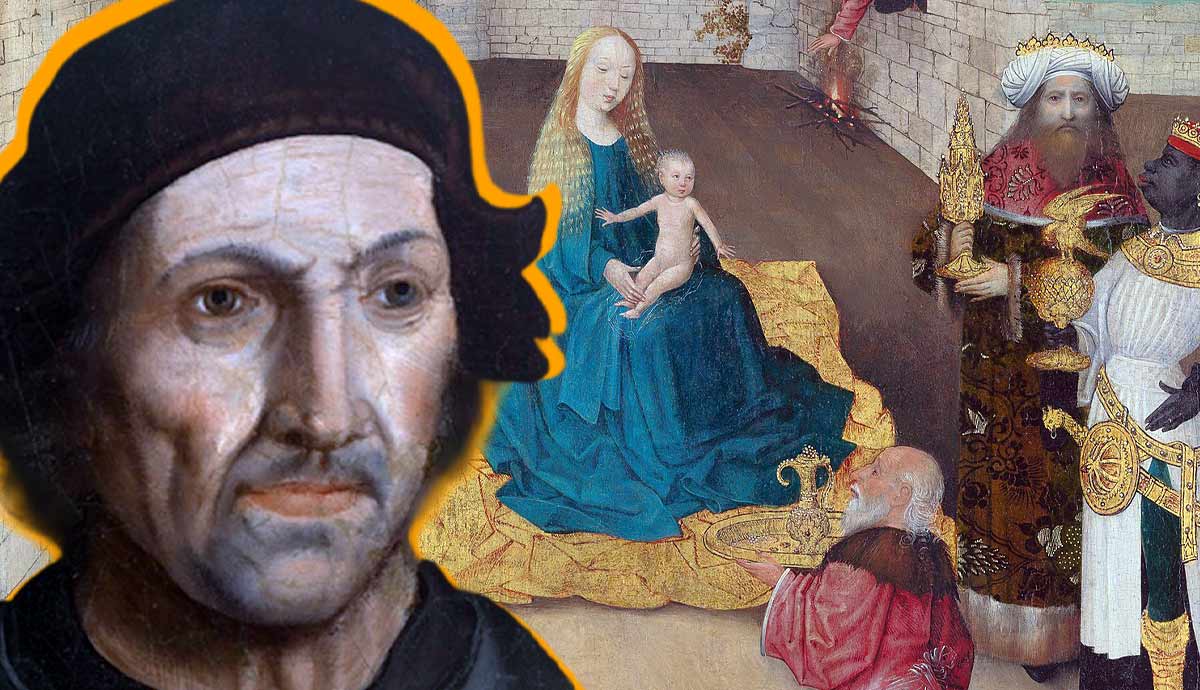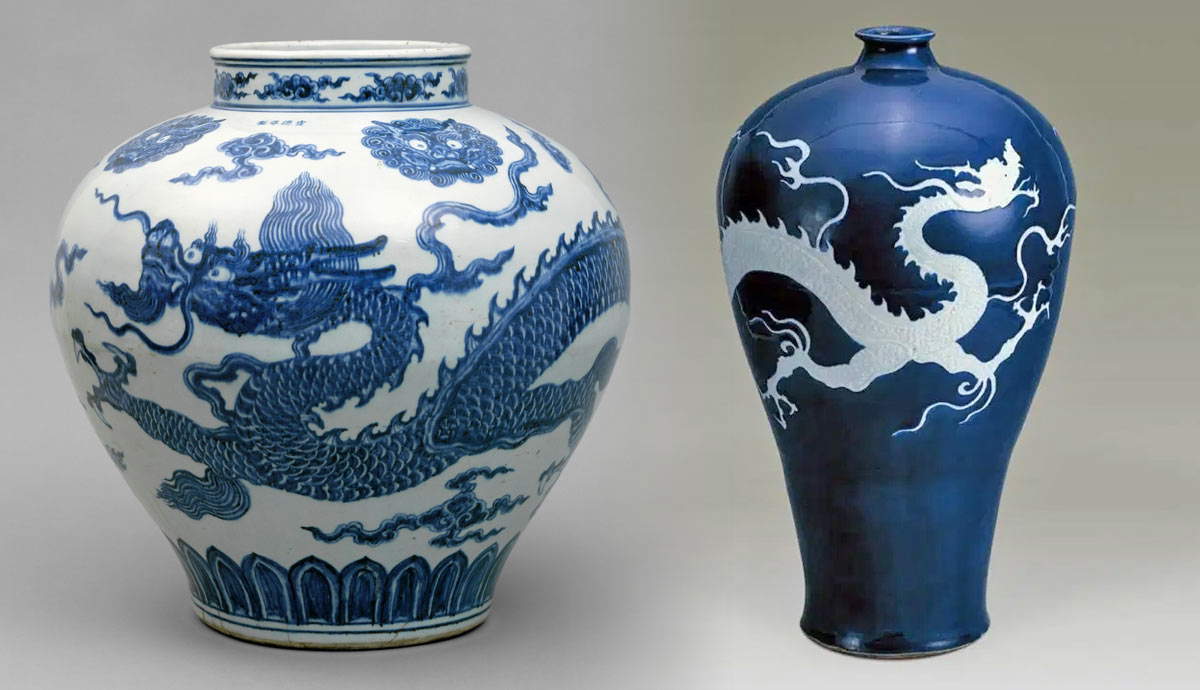
Ilya Repin was one of the most versatile and talented artists of his day and age. More than a century has passed since Ilya Repin’s Ivan the Terrible and His Son Ivan on 16 November 1581 was revealed to the public, and yet the work still manages to scare, provoke, and spark debate. Read on to learn more about the dark history of Repin’s Ivan the Terrible painting.
Before Repin’s “Ivan the Terrible”: The Real Story

Despite being one of the most famous Russian monarchs, Ivan IV the Terrible also has quite a lot of rumors, myths, and speculations surrounding his name. Indeed, the Tsar was ruthless, paranoid, and creative in his ways of torturing those who had fallen out of his favor, yet not all events of his life can be proven in the way they usually circulate in the media. Repin’s scene of choice represents one such case.
Indeed, Ivan IV had a son, Ivan Ivanovich, who died under strange circumstances. The most popular story concerns their conflict over the alleged dress code misconduct of the tsarevich’s pregnant wife and the miscarriage she had after the tsar attacked her for it. Another motive for the father-son clash could possibly be Ivan the Younger’s growing influence as a military leader who could allegedly challenge his father’s authority. In any case, Ivan the Terrible allegedly hit his son with a staff, causing him a severe head wound. Although the story has been retold in various historical records, there is no primary source to address, and no obvious direct link between the conflict and the tsarevich’s death.
In 1963, a team of researchers exhumed Tsarevich Ivan’s body. They discovered a staggering amount of lead, arsenic, and mercury in his remains with no apparent explanation. His skull, which could have given a clue about his cause of death, was too badly damaged by time to provide the scientists with any coherent evidence.
Ilya Repin’s Masterwork

Ukrainian-born painter Ilya Repin was one of the most talented and celebrated artists of the Russian Empire. He reacted deeply to the social and political events of his era and was well aware of the developing need for new forms of artistic expression. His painting of Ivan the Terrible is one of his masterworks that is surrounded by a dark reputation.
The principal inspiration for exploring such a gruesome subject came to Repin in 1881 after the assassination of Tsar Alexander II by a 25-year-old revolutionary, Ignacy Hryniewiecki. Hryniewiecki belonged to Narodnaya Volya (People’s Will), a socialist group that was known at the time for its direct and violent action against the government’s officials. Hryniewiecki killed himself with his target, and the rest of the group who arranged the attack were either killed on the spot or executed later. This wave of bloodshed and violence had a traumatic impact on Repin’s social circle and scarred both those who supported the monarchy and those who took the revolutionaries’ side.

In 1883, Ilya Repin traveled to Spain and witnessed the tradition of bullfights, with their blood and violence put on display. Once again, it brought his mind back to the 1881 bloodshed. In his mind, he envisioned a scene where a mad tyrant realized the depth of his depravity but was unable to take back his mistakes. Repin used several of his artist friends as well as regular people he met on the streets as models. The work had a dark and haunting impression on the artist himself, who lost command of his right arm soon after its completion and had to learn how to paint with his left.
In 1885, Repin presented a finished painting. Ivan the Terrible and His Son Ivan on 16 November 1581 had a devastating effect on Russian society. Outraged by such a disrespectful depiction of a Russian monarch, Tsar Alexander III banned the display of the work, but three months later lifted the ban.
The Attack

In January 1913, a young, nervously looking man entered the Tretyakov Gallery in Moscow. The gallery was a former private collection of various types of Russian art that its owner, famous textile merchant Pavel Tretyakov, had donated to the city. Tretyakov was a friend of Ilya Repin and one of his most loyal patrons. He also fiercely fought against Repin’s perfectionism and the habit of retouching his finished images. On several occasions, the artist sneaked into the gallery and painted over his works, changing shadows, colors, and details. Tretyakov was so offended by it that at some point he banned Repin from entry altogether. In that year, however, the hovering presence of the artist near the gallery doors proved to be useful.
A young man who visited the gallery on that day was a 28-year-old Orthodox icon painter, son of a prominent furniture manufacturer, Abram Balashov. Balashov was a so-called Old Believer, a member of a specific subgroup of Orthodox Christians who refused to accept the progressive 17th-century church reform. Instead, they chose to remain conservative, often rejecting the concept of the clergy as a social class. For centuries, the official Church suppressed and persecuted the Old Believers, yet their communities persisted. Today, the Old Believer groups live not only on the territory of the former Russian Empire but also in Romania, Australia, Canada, and Argentina.

Balashov was first noticed by gallery guards near the portrait of Feodosia Morozova, an activist of the Old Believer movement. He raised suspicion as the guard heard him whispering something as if he were talking to the portrait. Balashov then moved into the room with Repin’s paintings and suddenly attacked Ivan the Terrible with a gardening knife and slashed it. Yelling “Enough with blood, enough with murder,” he left three deep cuts in the canvas, completely destroying the right eye of the dead tsarevich and slashing the tsar’s face.
Balashov struck with such force that his knife got stuck in the wooden base of the frame. Immediately detained by the guards, he did not attempt to fight and just sat quietly, his face buried in his hands, until the police arrived. Citing the history of mental illnesses in Balashov’s family and the expertise of the attacker’s own unstable mental state, he was committed to an asylum. The psychiatrist suggested that the attack could have been triggered by Balashov’s troubled and abusive relationship with his father.

The detention of the attacker did not end the sequence of tragedies. For a while, the museum staff and Repin himself were sure that the work was destroyed beyond repair. The artist was hysterical and was sure he had lost one of his best works. Yet, the event left the most severe impact on the Tretyakov Gallery curator Georgy Khruslov, who threw himself under a moving train upon learning the news.
Both the attack and Khruslov’s suicide were a shock to the Moscow art community. Some, like the Symbolist poet Maximilian Voloshin, claimed that the work should be removed from public view as it incited violence and mental disturbance. Surprisingly, the restoration team managed to do the impossible. They removed Repin’s paint layer from the damaged canvas and transferred it to a new piece. Then, Repin was invited to paint the damaged fragments anew. For more than a century, the painting became known in its updated version and with a sinister reputation.
Repin’s “Ivan the Terrible” Attacked Again: The Pseudo-Political Case

In 2018, another attack occurred, as a drunken gallery visitor, Igor Podporin, threw a metal pole into the painting, shattering the glass and tearing the canvas. Podporin claimed his motive was a political one: he believed that Repin distorted the historical truth about the tsar and ruined his image in tune with the alleged Western propaganda. His ideas aligned with the claims of some conservative activists who called for declaring Ivan IV an Eastern Orthodox saint despite all of his crimes.
However, given Podporin’s personal apolitical background, some researchers believe his lawyer invented this reason to stir up public debate and secure the support of the conservatives. Podporin was sentenced to two and a half years in prison, and the painting, which suffered substantial damage, had to undergo a four-year restoration. Only in June 2022 was it presented to the public once again, this time in an anti-vandal case and under the close supervision of guards and curators.










